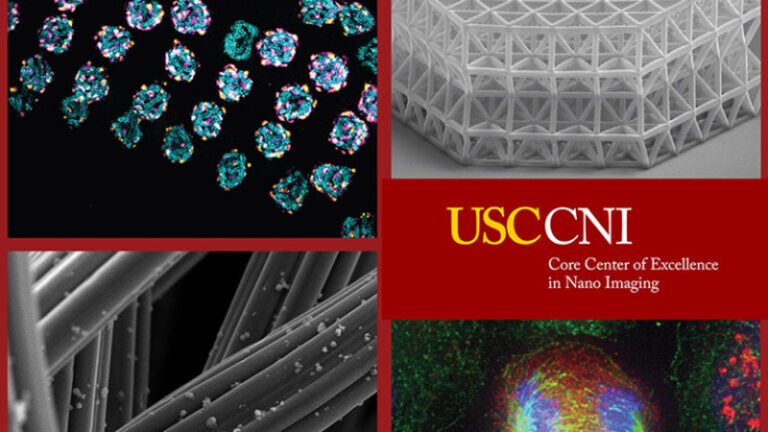
USC’s new cryogenic electron microscopy facility officially opens for business
Key takeaways:
- USC’s cryogenic electron microscopy (cryo-EM) facility is officially open.
- The cryo-EM lab offers state-of-the-art technology and staff expertise to researchers at USC and other academic institutions.
- The facility is part of an expanding effort through which academic research institutions like USC and for-profit organizations partner with the goal of speeding scientific advances.
USC’s new cryogenic electron microscopy (cryo-EM) facility, featuring state-of-the-art instrumentation capable of imaging molecules, garnered the spotlight during a recent symposium celebrating the facility’s official grand opening.
Scientists and officials from USC, biotechnology giant Amgen, Thermo Fisher Scientific and noted academic research institutions gathered for the event, held in March at the USC Michelson Center for Convergent Bioscience, where the cryo-EM facility is housed at the Core Center of Excellence in Nano Imaging.
Following remarks by several speakers, including USC President Carol L. Folt and Amber D. Miller, dean of the USC Dornsife College of Letters, Arts and Sciences, the day included scientific presentations and workshops focused primarily on structural biology and how cryo-EM aids the field.
Structural biology centers on studying the shapes of biological components, such as proteins and ribosomes, and how their shapes change as they perform their tasks within the cell. The field is important to understanding how molecules function within cells and to developing new therapies.
An early focus of the facility, single-particle cryo-EM allows structural biologists to visualize molecules and how they change when other molecules, such as new drugs, are present.
Miller noted the importance of USC’s new cryo-EM facility and the collaboration with Amgen and Thermo Fisher that brought the facility to the university.
“USC is now among the few places in the world where research in structural biology and medical science is truly conducted at the frontier, and this is thanks to this incredible partnership,” she said. “We are looking deeper into the machinery of the cells than anyone ever thought possible, and with our new cryo-EM capabilities, academic researchers and our corporate partners can take snapshots of biological molecules in three dimensions.”
Ray Deshaies, senior vice president of global research at Amgen, said the partnership that made the facility possible “could not be a more perfect union.”
“We (Amgen) can use the instrument to advance our mission of building therapeutics to treat patients with grievous illness, and meanwhile, USC can use it to advance the fundamental human knowledge in the biological and life sciences,” he said. “And in addition to doing cutting-edge research with the instrument, USC can also use it to educate the next generation of scientists.”
Deshaies noted the facility is the latest among several collaborations between USC and the Thousand Oaks-based biotech firm, including $7 million in support for the USC Schaeffer Center for Health Policy and Economics and a recent partnership with USC Norris Comprehensive Cancer Center and the Lazarex Cancer Foundation to establish Cancer Wellness HUBs.
In his introduction to a symposium session centered on drug discovery, USC Provost Charles Zukoski cited the need to expand collaboration between businesses in the drug development industry and academic research institutions to speed new therapies to patients.
He pointed to the rapid development of COVID-19 mRNA vaccines as an example of the potential for success. Universities created the initial vaccine technology, then private industry further developed these mRNA vaccine concepts and scaled up production so the vaccine could be distributed globally, saving millions of lives.
“This was truly transformational for human beings, for the globe,” Zukoski said.
Stephen Bradforth, senior advisor to the dean for research strategy and development at USC Dornsife, helped facilitate the agreement between USC, Amgen and Thermo Fisher that brought the cryo-EM facility to USC.
Another partnership with industry at the USC Michelson Center brought Agilent, a global research, development and manufacturing company, and USC together to establish the Agilent Center of Excellence in Biomolecular Characterization in 2018 and renew their alliance this year.
Bradforth noted that the USC cryo-EM facility is available for use by researchers not just at USC and Amgen, but other institutions, as well. He hopes the university’s collaborations with Amgen and Agilent spark similar beneficial arrangements with others in industry, and that it continues expansion of biotechnology in Southern California.